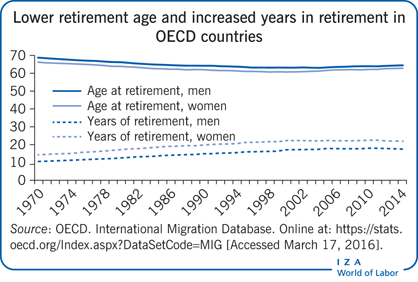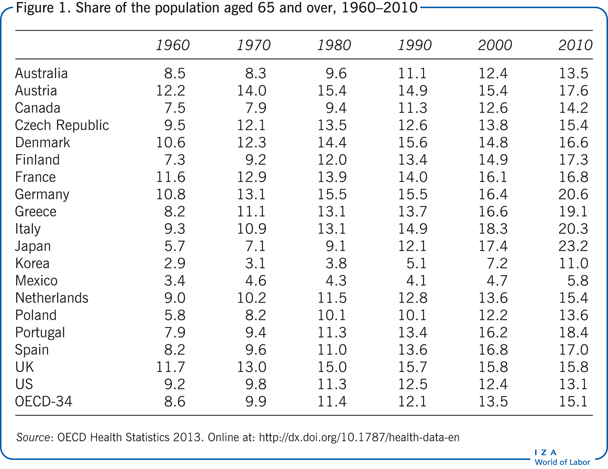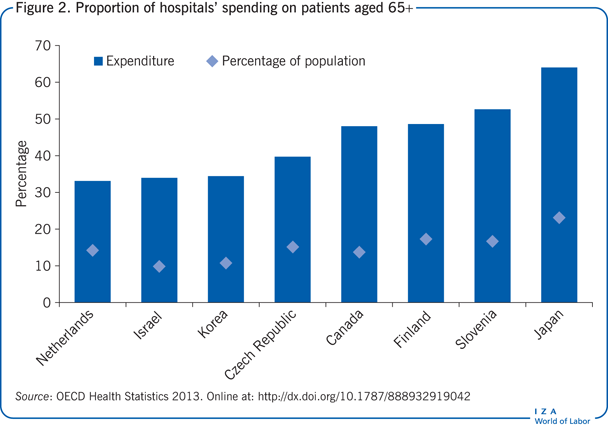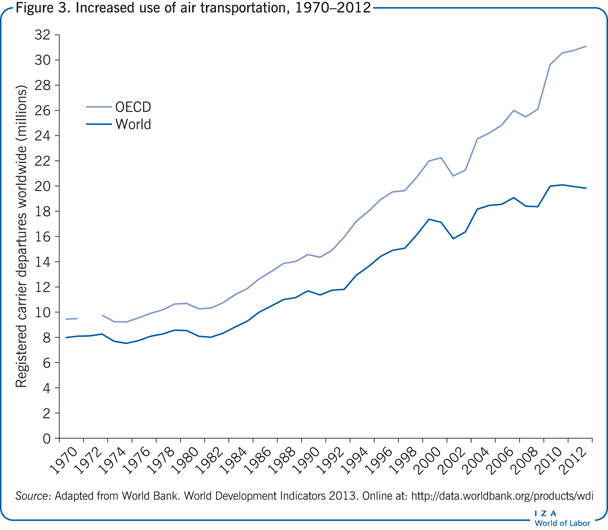Elevator pitch
As migration rates increase across the world, the choice of whether to retire in the host or home country is becoming a key decision for up to 15% of the world’s population, and this proportion is growing rapidly. Large waves of immigrants who re-settled in the second half of the 20th century are now beginning to retire. Although immigrants’ location choice at retirement is an area that has barely been studied, this decision has crucial implications for health care and social protection expenditures, both in host and origin countries.

Key findings
Pros
Immigrants returning to their origin countries at retirement can save costs for health care systems in the host country.
Decreasing travel costs help immigrants keep in physical contact with families and friends still living in their country of origin.
A third of retiring immigrants are choosing to split each year across their host and origin countries, traveling back and forth between them.
Improved coordination between countries on pension benefits would free up residential choices for immigrants at retirement.
Cons
The return of emigrants to their origin countries is likely to increase health and social care spending in those countries, where GDP per capita is on average lower than in their host country.
Income and wealth inequalities may increase in origin countries due to returning immigrants, potentially generating frustration and social unrest.
Health care is more likely to be accessed in host countries for acute health conditions, raising health care costs in those countries.
A lack of information about immigrants’ residential choices at retirement can impede government social expenditure planning for the retirement of immigrants.
Author's main message
The choice of country of residence at retirement has significant consequences for immigrants and for their host or home countries. It can imply moving away from children and friends, and impacts social and health care expenditures in the host and origin countries. Less costly and easier air transport may lead to more immigrants choosing to travel back and forth between their host and origin countries each year. Policymakers need to establish a better assessment and understanding of immigrants’ intentions at retirement, so that future social and health care costs can be anticipated and planned for at an earlier stage and better coordinated between host and origin countries.
Motivation
Many view immigration as a “one-time-only” move, whereby migrants decide to leave their country of origin to settle permanently in their chosen destination country. Indeed, early attempts at understanding and defining migration made no reference to the fact that it was in many cases a temporary phenomenon, as the focus was more on the effects of migration per se. But immigrants very often only plan to settle temporarily in their host country, with a view to productively reinvesting their accumulated savings and human capital back into their home country at some point in the future.
While the process of return migration during a migrant’s working life has since been studied and documented, one key and related decision has received very little attention: the decision on where to retire. Indeed, many immigrants who remain in their host country for the duration of their working life envisage a return to their home country at retirement. This decision is crucial for both the host and origin countries, as the retired population is growing at a fast rate and its demand for social and health care support is considerably greater than that of younger immigrants. This is particularly the case for immigrants working in physically demanding jobs that may negatively affect their health and mobility over the longer term.
It is important to understand the drivers and consequences of the decisions to retire in the home or the host country in order to identify gaps in the knowledge base and the policies needed to address them.
Discussion of pros and cons
Residential choices at retirement affect the planning of spending on health and social care
In many developed countries, spending on health care and social protection together amount to almost 50% of GDP; this number is expected to increase in the future. An aging population is often identified as being a key factor behind this increase, and the proportion of people aged 65 or over is growing rapidly across OECD countries. Between 1960 and 2010, the share of people aged 65 or over relative to the total population increased from 8.6% to 15.1% (Figure 1). By 2050, the average is expected to reach 27%. The proportion of people over 80 will grow even faster, from 4% to 10%, between 2010 and 2050.

While many immigrants arrived in their destination countries at a young age (typically in their early 20s), the majority of the (large) waves of migration during the second half of the 20th century began to reach retirement age from the 1990s onward. This retirement process is happening within the context of an overall aging population and has the potential to increase the health care and social protection needs of people aged over 65 in the host countries even further. Figure 2 shows that in OECD countries spending on health care for the population aged 65+ far exceeds their proportion in the total population.

The acute relevance of this issue is, however, not limited to host countries. Origin countries may find themselves in the perverse situation in which they lose workers at the point in their lives when they are healthiest and can contribute most to public spending through taxation, while then being the recipients of the same people who return home at retirement, when their needs in terms of social support and health care are the greatest. These negative effects of emigration (and return upon retirement) for origin countries are, however, counterbalanced to an extent by remittances sent home by nationals while they work in the host countries. Remittances are key contributors to economic development and improve well-being for families of migrants left behind in origin countries (contributing up to 40% of GDP for smaller countries). Overall, while the question of the net fiscal effect of emigration on origin countries remains largely under-researched, it is clear that return migration at the time of retirement would play an important role in this evaluation.
This question is very much related to and, to a certain extent, determined by health conditions for immigrants over the age of 65. There is a small amount of evidence that immigrants self-report poorer health after 65, but this does not appear to translate into greater use of medical care for immigrants relative to natives [1]. Also, it is widely documented that reduced education levels are associated with less healthy lifestyles and poorer health [2]. It is, then, probable that older immigrants—who may have been less educated than their native counterparts—may make greater use of health care in their old age than the native population in their host country. But the question remains largely open as to whether immigrants are more or less healthy than non-immigrants who stay in their origin country. And this leaves an important gap in our understanding of the net combined fiscal contribution of immigration to the host and origin countries.
What determines retirement choices?
Evidence shows that origin countries differ in their attractiveness for the return of older immigrants. For example, more Portuguese migrants in France expressed an intention to return at retirement than Italian or Spanish migrants (60% versus 43% and 34% respectively) [3]. While research investigating general return behavior finds that up to 50% of original migratory moves are followed by returns, figures at the time of retirement are patchy. It is known that return intention varies greatly between immigrants in different countries and also that the propensity to retire in the origin country, rather than in the host country, follows a similar geographical pattern [4].
While these differences deserve more research, some of the most important determinants of the residential choice at retirement, independently from country-specific preferences, are largely understood. At a time when work considerations are no longer relevant, people choose their residence location based on local amenities that are unrelated to employment, such as the quality of transport systems and access to affordable and efficient health care. Warmer and sunnier climes have also been found to attract people at retirement [5]; for example, there is a large population of British retirees who have chosen to retire in Spain (approximately half a million people). However, immigrants reaching their retirement in host countries face additional attracting and repellent factors compared to native retirees. Family and community ties are often spread across origin and host countries. Furthermore, parents of immigrants, if still alive, often remain in the origin countries. When they need informal health and social care, immigrant retirees frequently return and spend time with them in their origin countries [6].
However, it is more often the children of immigrants who are most influential in the choice of country of residence at retirement [7]. Children of immigrants often stay in the host country and may need their parents’ help and support with looking after their own children. Therefore informal childcare may require the presence of retired grandparents.
Number of siblings and birth order may also matter in the (re)location decision. There is evidence that lone children are more likely to live closer to their parents. There is also some (more contested) evidence that daughters are more likely to live closer, and provide informal care, to aging parents. It can thus be expected that lone children and daughters are more likely to return to their home country to take care of their parents.
Taxes may also become more relevant in retirees’ decisions to move. There is some evidence that higher property taxes induce retired people to move away to areas with lower property taxes [8]. But changes in income tax do not appear to generate significant emigration decisions for older, wealthier, retired residents.
Similarly, the decision to move can be related to the decision to reduce the size of residence following the drop in earnings that many face at retirement. A recent cross-country contribution looked at housing wealth de-accumulation (or equity release) across European countries. The study finds that this occurs more often in countries with more fluid mortgage markets, such as the US, the UK, Sweden, and Denmark, compared to countries with more rigid mortgage markets, such as Germany, France, Italy, and Spain [8]. As countries in the former group are recipients of very large cohorts of (aging) immigrants, it is possible that older immigrants retiring in countries with more fluid mortgage markets may downsize easier and relocate more often to their origin country. Another possibility is that the cash freed from the housing de-accumulation may allow more travel back and forth between the host and origin countries.
Another noteworthy determinant of return at retirement is whether migrants lose the right of residence in their host country when returning to their origin country [3]. This is the case when there are no free-movement agreements in place between the host and origin countries. Indeed, with the exception of intra-EU migration, many migrants face a stark choice between returning to their home country (and as a consequence losing their rights of residence) and staying in the host country. Free-movement agreements are more likely to exist between neighboring countries with similar levels of economic development. So the decision to return may involve going back to a country which is at an early stage of economic development combined with the loss of residence rights in their host country. Immigrants may need to trade off the benefits of the greater purchasing power of their pensions in their origin country with an irreversible decision not to be able to return to their host.
Are immigrants from poorer/richer countries more likely to stay/return?
There is growing evidence which suggests that the purchasing power parity (PPP), or the relative cost of living between countries, has an impact on the intended duration of stay in the host country and on return migration rates [10], [11]. However, the question of return at retirement has not been studied widely in the context of PPP, but a few key related explanatory factors have been discussed.
At retirement, a key driver of migration is an assessment of personal income, measured as pensions and returns on savings, rather than wages. Once retired, therefore, one’s standard of living will be enhanced by selecting the country where the purchasing power of pensions and accumulated savings is the highest. There are instances where unexpected volatility in exchange rates would reverse the optimal decision, but in most cases it is in the country of origin that greater purchasing power can be attained, as the pensions and savings accumulated in the host country will generally purchase a larger basket of goods and services in the origin country relative to the host country. It is therefore likely that retirees will be returning more frequently, and in greater numbers, the greater the difference in relative prices between the host and origin countries. Further, a generally accepted economic principle is that the less developed the country, the lower the relative price will be. It therefore might be expected that there would be more retirement migration to poorer countries. Indeed, the study referred to earlier in this article, which showed a greater intention among migrants to return to Portugal rather than Spain and Italy, appears to suggest that this mechanism could be at work there [3].
However, purchasing power is not the sole determinant behind the decision to return. There is an established literature showing that local amenities (including mild climate and quality and reliability of public infrastructure) are also key in the decision to return home or stay in the host country. Indeed, migrants may pay particular attention to the key amenities, such as transport and the health care system. Poorer countries in general do not compare favorably with richer host countries in this respect. In many cases, therefore, the decision to return home at retirement will need to balance greater purchasing power in the country of origin with a lesser quality of local (public) amenities (including health care systems) in those countries.
Better and cheaper transport systems allow increased mobility for immigrants at retirement
Improvements and deregulation in public and private transportation have allowed retirees (both immigrants and natives) to enjoy greater opportunities to travel. The price of air transport decreased by approximately 50% in real terms between 1992 and 2010 in Europe, and the total number of internal flights within Europe has trebled since 1970 (Figure 3). Retirees have much more spare time available than people of working age, and there is some evidence of a rapid increase in air travel by older people. This increase is likely to accelerate as waves of immigrants reach retirement age. Some countries have already adopted policies to attract immigrant retirees to purchase a second home in their origin country. These policies typically offer attractive short-term residential permits combined with tax exemptions (for example, Malaysia’s “My Second Home” program).

A third option: Traveling back and forth between the host and origin country
As discussed earlier, migration is no longer considered to be a one-time-only move [12]. At retirement, earnings are not generated through participation in a particular labor market in the host country, and residential choices are no longer determined by current employment. Greater individual freedom of residential choice allows a range of strategies to be considered by retirees, including choosing to reside in different countries throughout the year.
The possibility for immigrants to travel back and forth is now attracting the attention of the airline industry [13]. Indeed, the growing stock of immigrants who are retired and active, combined with easier access to air transport, and lower airline ticket prices, has the potential to generate a substantial area of growth for air transportation. Airlines have already responded to this demand by setting up facilities for frequent flyers to travel to their home countries. Assessing the contribution of this greater propensity to travel on increasing air and noise pollution has not yet been attempted, but is also likely to be of some importance.
In a survey of 6,000 older immigrants living in France, and not yet retired in the period 2004–2005, more than 30% declared the “traveling back and forth” option as their preferred choice following retirement [6]. This solution appears particularly attractive during the first period following retirement (the so-called “third age”), as it avoids making a definite location choice at the time of retirement. This option is, however, perhaps limited to the initial period post-retirement when, in general, retirees’ mental and physical condition allows regular movement between different countries. But it is not a solution that is generally feasible in the longer term, when potentially debilitating medical conditions begin to appear and personal mobility becomes more impaired.
The “back and forth” option has also been studied by sociologists, who maintain that having children living in the host country tends to reduce the number of journeys home taken by their parents and to increase the number of those who choose to travel back and forth between the host and origin countries. Involvement in various networks in the host country, such as unions and community initiatives, also tends to increase the probability of immigrants remaining in the host country or traveling back and forth.
It is also suggested in this literature that immigrants tend to retire to their country of origin more frequently when they value the health care system in their home country more highly than that in their host country (as appears to be case for Spanish immigrants in Switzerland, for example).
Overall, the strategy of spending part of the year in the host country and part in the origin country has undoubtedly benefitted from easier access to air transport as well as from rapid progress in online communication, which helps “back-and-forth” retirees to maintain close links with family and friends who have remained in their origin country. It also appears that the next of kin are a determinant of this strategy. This is the case when children decide to settle in the host country, but immigrant retirees had planned to return after a spell abroad (which can encompass their entire working life).
Limitations and gaps
There are significant gaps in the knowledge base on the residential choices of immigrants at the time of retirement. The lack of evidence on intended country of residence and the extent of back-and-forth travel envisaged is particularly acute. Immigrants’ preferences toward national health care systems (in the host or origin country) also appear to have been ignored. These gaps call for host countries to introduce additional questions in national surveys on country of living intentions at retirement and preferences toward health care systems. Actual behaviors move in parallel with intentions, so such surveys would provide essential insights.
This information is crucial for governments to predict the appropriate levels of investment in health and social care, both in the host and the origin country. With growing flows of immigration, and large waves having emigrated in the second half of the 20th century, more state funding is increasingly warranted in these areas.
Summary and policy advice
As people retire, they become less constrained as to where they choose to live. Among all retirees, immigrants are possibly the most mobile, due to pre-existing ties with their country of origin. With a growing share of the workforce made up of immigrants, the implications for social and health care funding should not be underestimated.
This suggests that new international agreements (bilateral or multilateral) should be implemented to determine which country should bear the costs of providing health and social protection to retired immigrants. Current policy relies on the general principle that the country of residence is supplying those services and should cover the incurred costs. However, the system generates considerable uncertainties, given the potential for immigrants to pick and choose the preferred system through migratory moves, including operating a back-and-forth move between their host and origin countries.
As underlined by a survey undertaken by the World Health Organization in 2015 in the related area of health tourism, a legal framework offering clear guidance to patients (on costs, care, and waiting times) and regarding an agreed distribution of costs between the host and origin countries, is clearly needed. Such agreements can be modeled on existing agreements between neighboring EU member states. An EU directive on cross-border health care, introduced in 2011, provides a good starting point.
Questions on years since migration and intended duration of stay could be included in major (annual and/or quarterly) surveys, such as national labor force surveys, socio-economic panels and/or decennial censuses. Immigrants could also be interviewed more frequently regarding their intentions to remain or return.
In conclusion, there is a need for more communication between governments and retirees (particularly immigrants) regarding retirement plans, and for greater coordination between host and origin countries to plan for the outcomes and to offer retirees a clearer and better-informed choice about country of residence.
Acknowledgments
The author thanks two anonymous referees and the IZA World of Labor editors for many helpful suggestions on earlier drafts.
Competing interests
The IZA World of Labor project is committed to the IZA Guiding Principles of Research Integrity. The author declares to have observed these principles.
© Augustin De Coulon